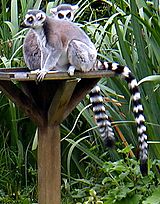Euarchontoglires facts for kids
Quick facts for kids EuarchontogliresTemporal range: Upper Cretaceous – Recent
|
|
|---|---|
 |
|
| Ring-tailed Lemurs (Lemur catta) | |
| Scientific classification | |
| Kingdom: | |
| Class: | |
| Infraclass: | |
| Superorder: |
Euarchontoglires
|
| Orders | |
|
See text |
|
Euarchontoglires (say it: Yoo-ARK-on-toh-GLY-rees) is a big group of mammals that includes many animals you know, like rodents and primates. This superorder is part of the larger group called Placentalia, which are mammals that develop inside their mother's body using a special organ called a placenta.
Contents
What are Euarchontoglires?
Euarchontoglires is a scientific name for a very large group of mammals. Think of it like a big family tree. This group includes animals that might seem very different at first glance, but they all share a common ancestor. This means they are all related, even if some look like tiny mice and others are large monkeys!
Where do they fit in?
To understand where Euarchontoglires fit, imagine a giant family tree for all mammals.
- First, you have all Mammals.
- Then, within mammals, there's a big branch called Placentalia. These are mammals whose babies grow inside their mothers with a placenta.
- Placentalia then splits into different groups:
- Afrotheria (like elephants and aardvarks)
- Exafroplacentalia
- Xenarthra (like sloths and armadillos)
- Boreoeutheria
- Laurasiatheria (like cats, dogs, and horses)
- Euarchontoglires (our group!)
So, Euarchontoglires are a major branch of the Boreoeutheria, which itself is a branch of Placentalia.
Meet the Groups!
The Euarchontoglires superorder is divided into two main groups: Glires and Euarchonta. Each of these groups then has smaller orders within them.
Glires: Rodents and Rabbits
The Glires group includes two very common types of mammals:
- Rodentia (Rodents): This is the largest group of mammals! It includes animals like mice, rats, squirrels, beavers, guinea pigs, and hamsters. They are known for their strong, continuously growing front teeth (incisors) that they use for gnawing.
- Lagomorpha (Rabbits, Hares, and Pikas): This group includes rabbits, hares, and pikas. While they look a bit like rodents, they have some key differences, like having an extra pair of small incisors behind their main front teeth.
Euarchonta: Primates and More
The Euarchonta group is where you'll find some of the most familiar and fascinating animals, including humans!
- Dermoptera (Colugos): These are also known as "flying lemurs," even though they aren't true lemurs and they don't actually fly. They are amazing gliding mammals found in Southeast Asia. They have a large membrane of skin that stretches from their neck to their fingers, toes, and tail, allowing them to glide long distances between trees.
- Primatomorpha
- Scandentia (Treeshrews): These small mammals look a bit like squirrels but are more closely related to primates. They live in tropical forests in Southeast Asia and are very active during the day, often searching for insects and fruit.
- Primates (Monkeys, Apes, and Humans): This is the group that includes monkeys, apes, and humans. Primates are known for their grasping hands and feet, large brains, and often good eyesight. This group is incredibly diverse, from tiny marmosets to gorillas and, of course, us!
See also
Euarcontoglires para niños (Euarcontoglires for children in Spanish)

